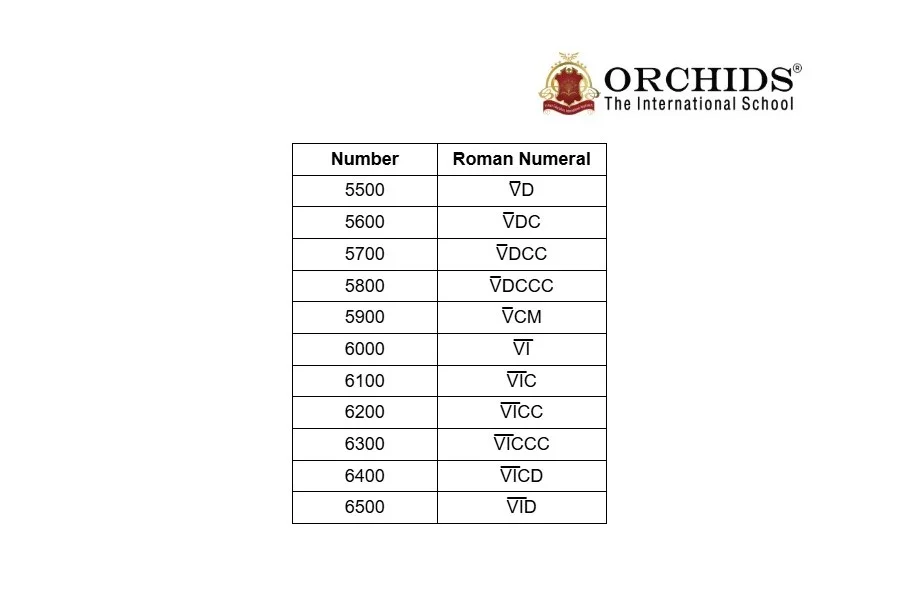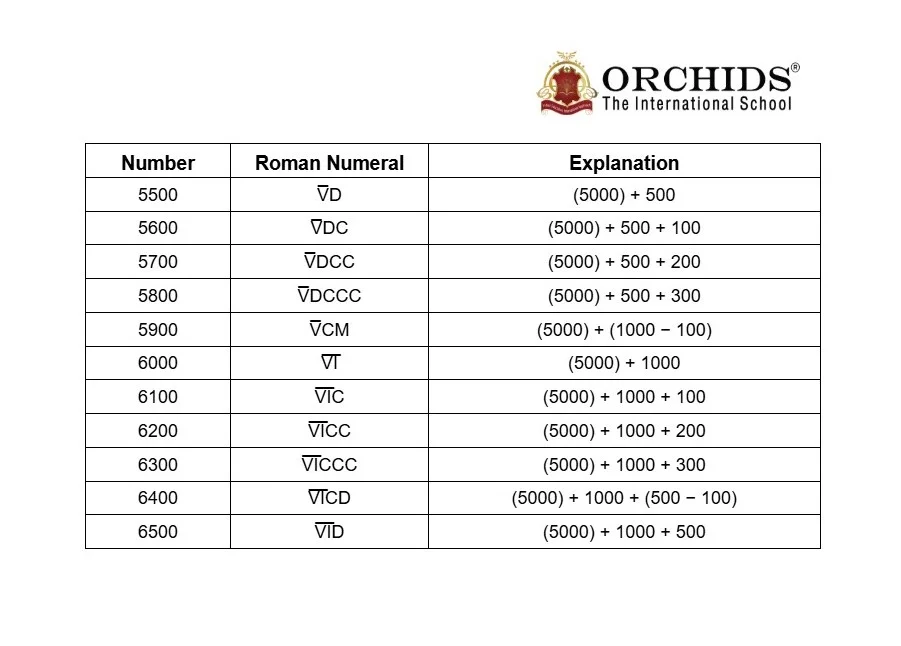6000 in Roman Numerals
6000 in Roman numerals is written as V̅I̅, an ancient way used by the Romans to display numbers. This numeral form uses letters to represent values, where V̅I̅ means 5,000, plus 1,000. Understanding how to read and write numbers as 6000 in Roman numerals, helps students connect mathematics. It also improves logical thinking by teaching them how values are combined to form larger numbers. The study of V̅I̅ is not only a mathematical skill but also a link to the past, which makes number learning interesting in everyday life.
Table of Contents
- How to Write 6000 in Roman Numerals
- Basic Rules to Write 6000 in Roman Numerals
- Roman Numerals 6000 Conversion Chart
- Roman Numerals 6000 Explanation Table
- Solved Examples on Roman Numerals
- Facts About 6000 in Roman Numerals
- Practice Question
- Conclusion
- FAQs on 6000 in Roman Numerals
How to Write 6000 in Roman Numerals
To write 6000 in Roman numerals, break it into thousands, hundreds, tens, and ones using additive and subtractive pairs:
Step-by-step:
-
V̅ = 5,000
- I̅ = 1,000
Add them: 5,000 + 1,000 = 6,000
Therefore, 6,000 in Roman numerals is V̅I̅.
Basic Rules to Write 6000 in Roman Numerals
To write 6000 in Roman numerals, students should follow these simple rules based on the Roman Numeral System:
Know the values:
-
I = 1
-
V = 5
-
X = 10
-
L = 50
-
C = 100
-
D = 500
-
M = 1000
-
V̅ = 5000 (overline multiplies by 1000)
-
I̅ = 1000 (overline on I = 1000)
Use overlines for thousands (extended notation):
-
An overline above a numeral means “× 1000.” So V̅ is 5000, and I̅ is 1000.
Write numerals in order from largest to smallest:
-
Start with the largest value: V̅ (5000), then add I̅ (1000).
Add the values when smaller or equal numerals follow larger ones:
-
V̅ (5000) + I̅ (1000) = 6000.
No subtractive rules needed for 6000:
-
Since 6000 is a straightforward sum, no pairs like IV, IX, etc., are needed.
Therefore, 6000 in Roman numerals is V̅I̅.
Roman Numerals 6000 Conversion Chart

id="roman-numerals-6000-explanation-table" dir="ltr">Roman Numerals 6000 Explanation Table

Solved Examples on Roman Numerals 6000
Example 1: A museum catalogue shows V̅ artifacts in storage and adds I̅ newly found pieces. Write the total in Roman numerals.
Solution:
V̅ = 5000, I̅ = 1000
5000 + 1000 = 6000
Therefore, 6000 = V̅I̅.
Example 2: Combine these numerals and simplify: V̅ + M.
Solution:
V̅ (5000) + M (1000) = 6000
Therefore, total = V̅I̅.
Example 3: A warehouse logs MMM crates in the morning and MMM in the evening. Express the day’s total in Roman numerals.
Solution:
3000 + 3000 = 6000
Therefore, 6000 = MMMMMM (also written as V̅I̅ using an overline).
Example 4: Fill in the blank using overline notation: V̅ + ___ = 6000.
Solution:
V̅ = 5000, so we need 1000 = I̅ (or M)
Therefore, V̅ + I̅ = V̅I̅ = 6000.
Example 5: Start from X̅ (10,000) and subtract I̅V̅ (4,000). Write the result in Roman numerals.
Solution:
10,000 − 4,000 = 6,000
Therefore, 6000 = V̅I̅.
Facts About 6000 in Roman Numerals
-
Roman Numeral: 6000 is written as V̅I̅ (V̅ = 5000, I̅ = 1000; 5000 + 1000).
-
Extended Notation: The overline means “×1000.” That’s why V̅ is 5000 and I̅ is 1000.
-
Alternative Form: You can also write 6000 as MMMMMM (six M’s) in additive form.
-
No Subtractive Form Needed: 6000 is written by addition; no pairs like IV or IX are required.
-
Even Number: 6000 is even; some divisors include 1, 2, 3, 4, 5, 6, 8, 10, 12, …, 3000, and 6000.
Practice Questions
-
How do you write the number 6000 using overline notation?
-
Write 6000 without overlines using only M’s?
-
Convert V̅I̅ into the regular decimal number?
-
Calculate V̅ + M and write your answer in Roman numerals.?
-
Starting from X̅ (10,000), what Roman numeral do you get if you subtract I̅V̅ (4000)?
Conclusion
In Roman numerals, 6000 is written as V̅I̅ by placing a vinculum (a bar) over the letters VI, which represent 6. The bar means the value is multiplied by 1,000, so VI (6) becomes 6,000. This is a simple example that helps students to understand how Roman numerals are used similarly to creating numbers. Learning it also makes it easier to read and write different Roman numerals.
FAQs on 6000 in Roman Numerals
1. What is the Roman numeral for 6000?
The Roman numeral for 6000 is V̅I̅ (V and I with a bar called a vinculum).
In Roman numerals, an overline placed above a symbol means its value is multiplied by 1000.
2. How Do You Write 6000 in Roman Numerals?
Here’s how 6000 is represented step by step:
-
The numeral V equals 5.
-
Placing an overline on top (V̅) multiplies it by 1000 → V̅ = 5000.
-
Add I̅ (which is 1000 × 1 = 1000).
So, V̅ (5000) + I̅ (1000) = 6000
6000 = V̅I̅
3. Why Is It Written as V̅I̅?
It’s written as V̅I̅ because the overline system represents thousands.
-
V̅ = 5000
-
I̅ = 1000
When combined, they make 6000.
4. Are There Other Ways to Write 6000 in Roman Numerals?
The correct way to write 6,000 in Roman numerals is as V̅I̅, which means VI (6) with a bar placed over it to indicate multiplication by 1,000 (6 × 1,000 = 6,000).
5. Which value should we add to 3000 to Get 6000?
To find the missing value:
6000 – 3000 = 3000
In Roman numerals:
MMM (3000) + MMM (3000) = V̅I̅ (6000)
So, we add MMM (3000) to MMM (3000) to make 6000 (V̅I̅).
At Orchids The International School, we make learning simple and engaging. Explore more Maths concepts, Roman numeral lessons, and fun practice for every grade.
Related Links
Admissions Open for
Admissions Open for
CBSE Schools In Popular Cities
- CBSE Schools in Bangalore
- CBSE Schools in Mumbai
- CBSE Schools in Pune
- CBSE Schools in Hyderabad
- CBSE Schools in Chennai
- CBSE Schools in Gurgaon
- CBSE Schools in Kolkata
- CBSE Schools in Indore
- CBSE Schools in Sonipat
- CBSE Schools in Delhi
- CBSE Schools in Rohtak
- CBSE Schools in Bhopal
- CBSE Schools in Aurangabad
- CBSE Schools in Jabalpur
- CBSE Schools in Jaipur
- CBSE Schools in Jodhpur
- CBSE Schools in Nagpur
- CBSE Schools in Ahmednagar
- CBSE School In Tumkur











